Qantas Airlines Domestic: Research Report on Value Chain Analysis
VerifiedAdded on 2023/04/07
|8
|1400
|267
Report
AI Summary
This report provides a comprehensive analysis of Qantas Airlines' domestic operations, utilizing Porter's Value Chain model as a framework. The analysis begins with an overview of Qantas's background, including its market position, revenue, and key competitors within the Australian domestic airline market. The report then delves into the application of Porter's Value Chain, breaking down Qantas's activities into primary and support categories. Primary activities examined include inbound logistics, outbound logistics, operations, sales and marketing, and service, with detailed descriptions of each area specific to Qantas's operations. The support activities, including infrastructure, technology, human resource management, and procurement, are also analyzed, highlighting Qantas's strengths and areas for potential improvement. The methodology section outlines the mixed research approach needed for further research, emphasizing the use of both qualitative and quantitative data collection from primary and secondary sources. The report concludes by referencing the provided sources. The report adheres to the requirements of the assignment brief, focusing on the application of Porter's Value Chain to analyze Qantas's domestic business, identify its strengths and weaknesses, and explore potential strategies for market share growth.
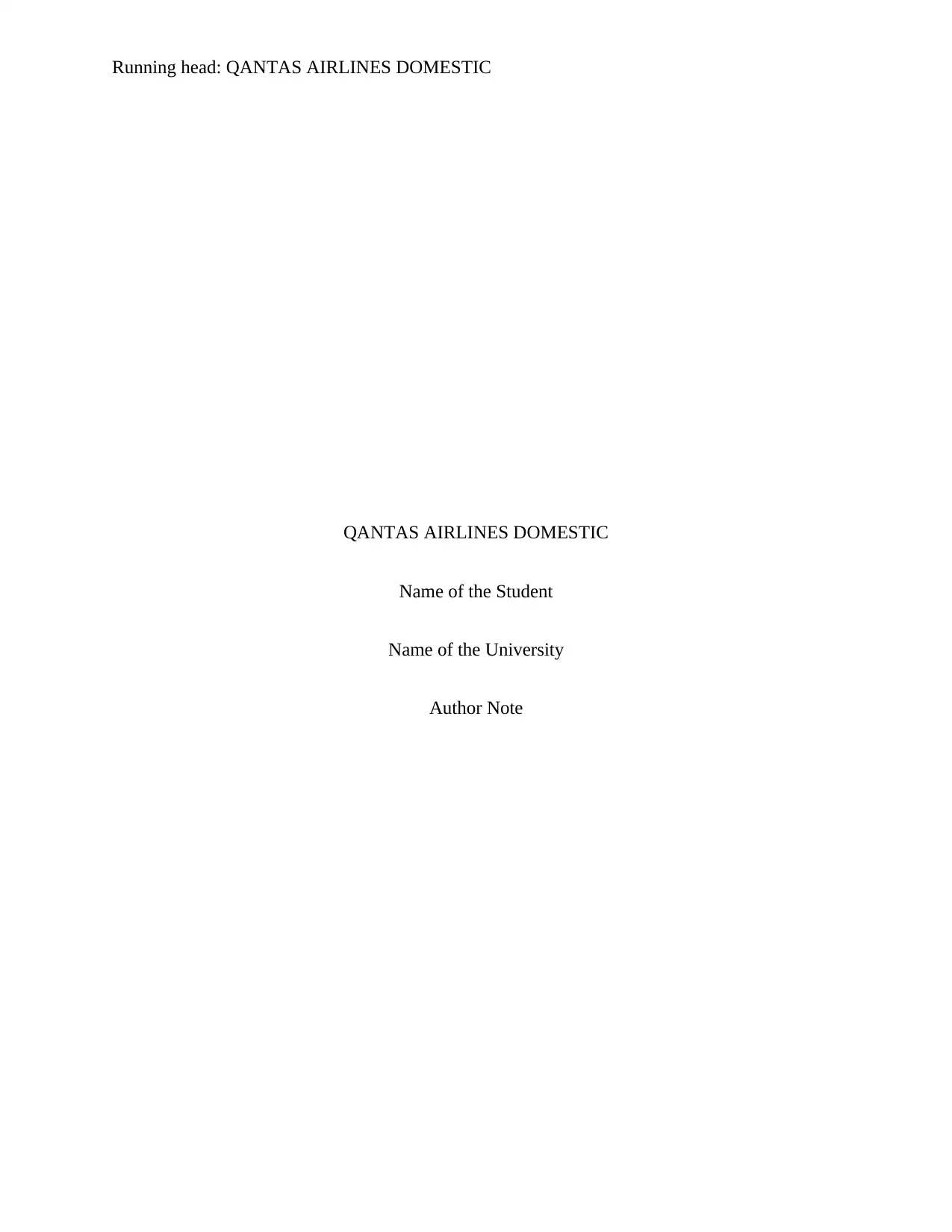
Running head: QANTAS AIRLINES DOMESTIC
QANTAS AIRLINES DOMESTIC
Name of the Student
Name of the University
Author Note
QANTAS AIRLINES DOMESTIC
Name of the Student
Name of the University
Author Note
Paraphrase This Document
Need a fresh take? Get an instant paraphrase of this document with our AI Paraphraser
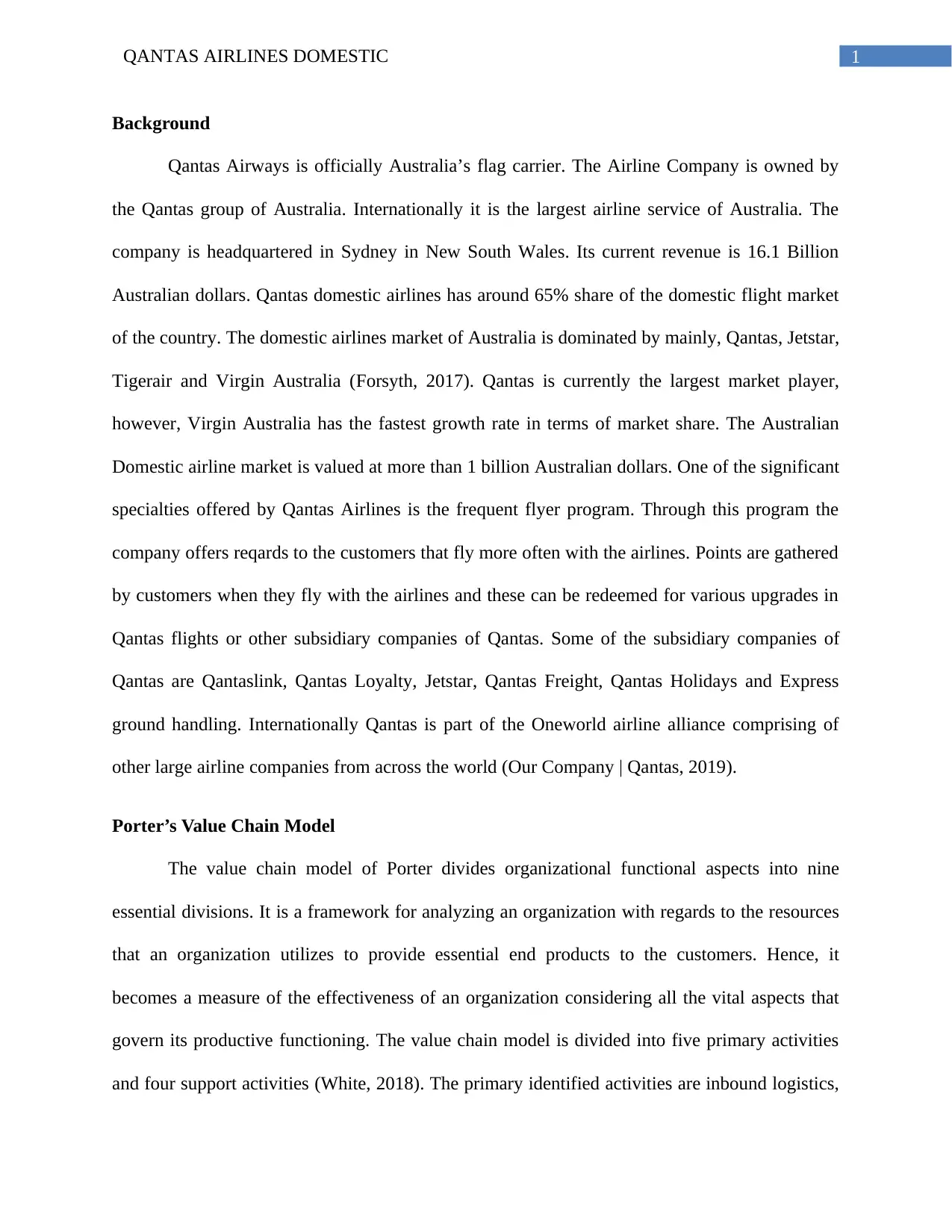
1QANTAS AIRLINES DOMESTIC
Background
Qantas Airways is officially Australia’s flag carrier. The Airline Company is owned by
the Qantas group of Australia. Internationally it is the largest airline service of Australia. The
company is headquartered in Sydney in New South Wales. Its current revenue is 16.1 Billion
Australian dollars. Qantas domestic airlines has around 65% share of the domestic flight market
of the country. The domestic airlines market of Australia is dominated by mainly, Qantas, Jetstar,
Tigerair and Virgin Australia (Forsyth, 2017). Qantas is currently the largest market player,
however, Virgin Australia has the fastest growth rate in terms of market share. The Australian
Domestic airline market is valued at more than 1 billion Australian dollars. One of the significant
specialties offered by Qantas Airlines is the frequent flyer program. Through this program the
company offers reqards to the customers that fly more often with the airlines. Points are gathered
by customers when they fly with the airlines and these can be redeemed for various upgrades in
Qantas flights or other subsidiary companies of Qantas. Some of the subsidiary companies of
Qantas are Qantaslink, Qantas Loyalty, Jetstar, Qantas Freight, Qantas Holidays and Express
ground handling. Internationally Qantas is part of the Oneworld airline alliance comprising of
other large airline companies from across the world (Our Company | Qantas, 2019).
Porter’s Value Chain Model
The value chain model of Porter divides organizational functional aspects into nine
essential divisions. It is a framework for analyzing an organization with regards to the resources
that an organization utilizes to provide essential end products to the customers. Hence, it
becomes a measure of the effectiveness of an organization considering all the vital aspects that
govern its productive functioning. The value chain model is divided into five primary activities
and four support activities (White, 2018). The primary identified activities are inbound logistics,
Background
Qantas Airways is officially Australia’s flag carrier. The Airline Company is owned by
the Qantas group of Australia. Internationally it is the largest airline service of Australia. The
company is headquartered in Sydney in New South Wales. Its current revenue is 16.1 Billion
Australian dollars. Qantas domestic airlines has around 65% share of the domestic flight market
of the country. The domestic airlines market of Australia is dominated by mainly, Qantas, Jetstar,
Tigerair and Virgin Australia (Forsyth, 2017). Qantas is currently the largest market player,
however, Virgin Australia has the fastest growth rate in terms of market share. The Australian
Domestic airline market is valued at more than 1 billion Australian dollars. One of the significant
specialties offered by Qantas Airlines is the frequent flyer program. Through this program the
company offers reqards to the customers that fly more often with the airlines. Points are gathered
by customers when they fly with the airlines and these can be redeemed for various upgrades in
Qantas flights or other subsidiary companies of Qantas. Some of the subsidiary companies of
Qantas are Qantaslink, Qantas Loyalty, Jetstar, Qantas Freight, Qantas Holidays and Express
ground handling. Internationally Qantas is part of the Oneworld airline alliance comprising of
other large airline companies from across the world (Our Company | Qantas, 2019).
Porter’s Value Chain Model
The value chain model of Porter divides organizational functional aspects into nine
essential divisions. It is a framework for analyzing an organization with regards to the resources
that an organization utilizes to provide essential end products to the customers. Hence, it
becomes a measure of the effectiveness of an organization considering all the vital aspects that
govern its productive functioning. The value chain model is divided into five primary activities
and four support activities (White, 2018). The primary identified activities are inbound logistics,
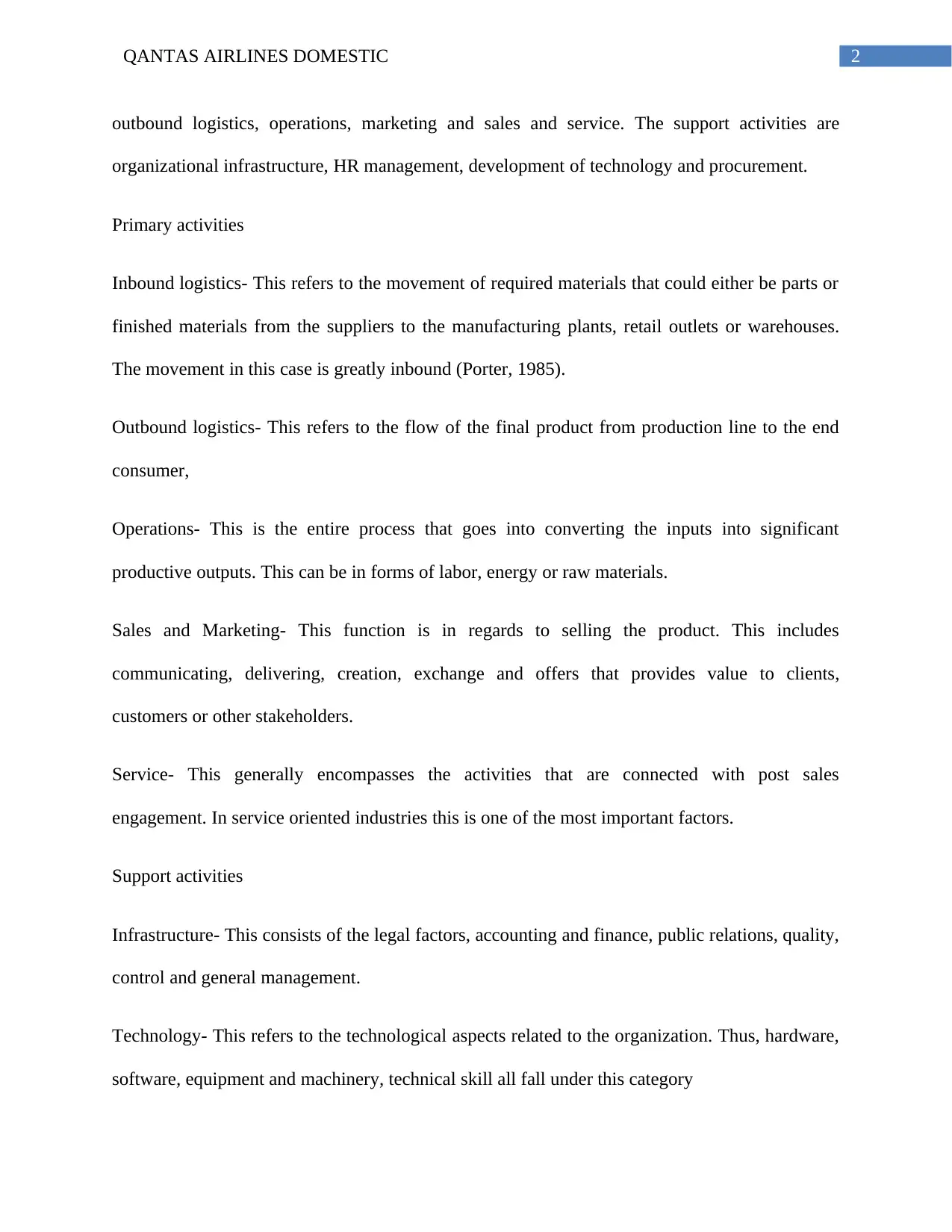
2QANTAS AIRLINES DOMESTIC
outbound logistics, operations, marketing and sales and service. The support activities are
organizational infrastructure, HR management, development of technology and procurement.
Primary activities
Inbound logistics- This refers to the movement of required materials that could either be parts or
finished materials from the suppliers to the manufacturing plants, retail outlets or warehouses.
The movement in this case is greatly inbound (Porter, 1985).
Outbound logistics- This refers to the flow of the final product from production line to the end
consumer,
Operations- This is the entire process that goes into converting the inputs into significant
productive outputs. This can be in forms of labor, energy or raw materials.
Sales and Marketing- This function is in regards to selling the product. This includes
communicating, delivering, creation, exchange and offers that provides value to clients,
customers or other stakeholders.
Service- This generally encompasses the activities that are connected with post sales
engagement. In service oriented industries this is one of the most important factors.
Support activities
Infrastructure- This consists of the legal factors, accounting and finance, public relations, quality,
control and general management.
Technology- This refers to the technological aspects related to the organization. Thus, hardware,
software, equipment and machinery, technical skill all fall under this category
outbound logistics, operations, marketing and sales and service. The support activities are
organizational infrastructure, HR management, development of technology and procurement.
Primary activities
Inbound logistics- This refers to the movement of required materials that could either be parts or
finished materials from the suppliers to the manufacturing plants, retail outlets or warehouses.
The movement in this case is greatly inbound (Porter, 1985).
Outbound logistics- This refers to the flow of the final product from production line to the end
consumer,
Operations- This is the entire process that goes into converting the inputs into significant
productive outputs. This can be in forms of labor, energy or raw materials.
Sales and Marketing- This function is in regards to selling the product. This includes
communicating, delivering, creation, exchange and offers that provides value to clients,
customers or other stakeholders.
Service- This generally encompasses the activities that are connected with post sales
engagement. In service oriented industries this is one of the most important factors.
Support activities
Infrastructure- This consists of the legal factors, accounting and finance, public relations, quality,
control and general management.
Technology- This refers to the technological aspects related to the organization. Thus, hardware,
software, equipment and machinery, technical skill all fall under this category
⊘ This is a preview!⊘
Do you want full access?
Subscribe today to unlock all pages.

Trusted by 1+ million students worldwide
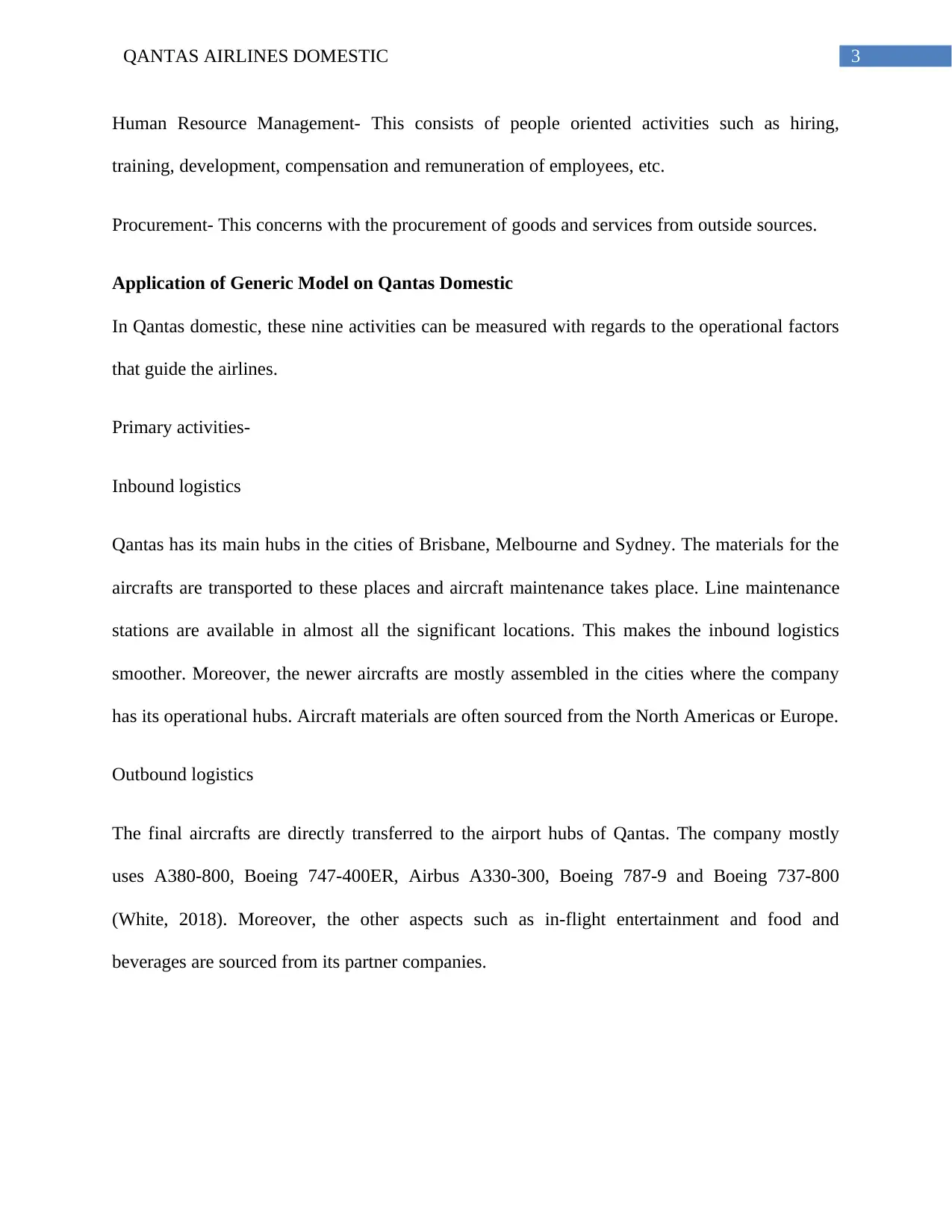
3QANTAS AIRLINES DOMESTIC
Human Resource Management- This consists of people oriented activities such as hiring,
training, development, compensation and remuneration of employees, etc.
Procurement- This concerns with the procurement of goods and services from outside sources.
Application of Generic Model on Qantas Domestic
In Qantas domestic, these nine activities can be measured with regards to the operational factors
that guide the airlines.
Primary activities-
Inbound logistics
Qantas has its main hubs in the cities of Brisbane, Melbourne and Sydney. The materials for the
aircrafts are transported to these places and aircraft maintenance takes place. Line maintenance
stations are available in almost all the significant locations. This makes the inbound logistics
smoother. Moreover, the newer aircrafts are mostly assembled in the cities where the company
has its operational hubs. Aircraft materials are often sourced from the North Americas or Europe.
Outbound logistics
The final aircrafts are directly transferred to the airport hubs of Qantas. The company mostly
uses A380-800, Boeing 747-400ER, Airbus A330-300, Boeing 787-9 and Boeing 737-800
(White, 2018). Moreover, the other aspects such as in-flight entertainment and food and
beverages are sourced from its partner companies.
Human Resource Management- This consists of people oriented activities such as hiring,
training, development, compensation and remuneration of employees, etc.
Procurement- This concerns with the procurement of goods and services from outside sources.
Application of Generic Model on Qantas Domestic
In Qantas domestic, these nine activities can be measured with regards to the operational factors
that guide the airlines.
Primary activities-
Inbound logistics
Qantas has its main hubs in the cities of Brisbane, Melbourne and Sydney. The materials for the
aircrafts are transported to these places and aircraft maintenance takes place. Line maintenance
stations are available in almost all the significant locations. This makes the inbound logistics
smoother. Moreover, the newer aircrafts are mostly assembled in the cities where the company
has its operational hubs. Aircraft materials are often sourced from the North Americas or Europe.
Outbound logistics
The final aircrafts are directly transferred to the airport hubs of Qantas. The company mostly
uses A380-800, Boeing 747-400ER, Airbus A330-300, Boeing 787-9 and Boeing 737-800
(White, 2018). Moreover, the other aspects such as in-flight entertainment and food and
beverages are sourced from its partner companies.
Paraphrase This Document
Need a fresh take? Get an instant paraphrase of this document with our AI Paraphraser
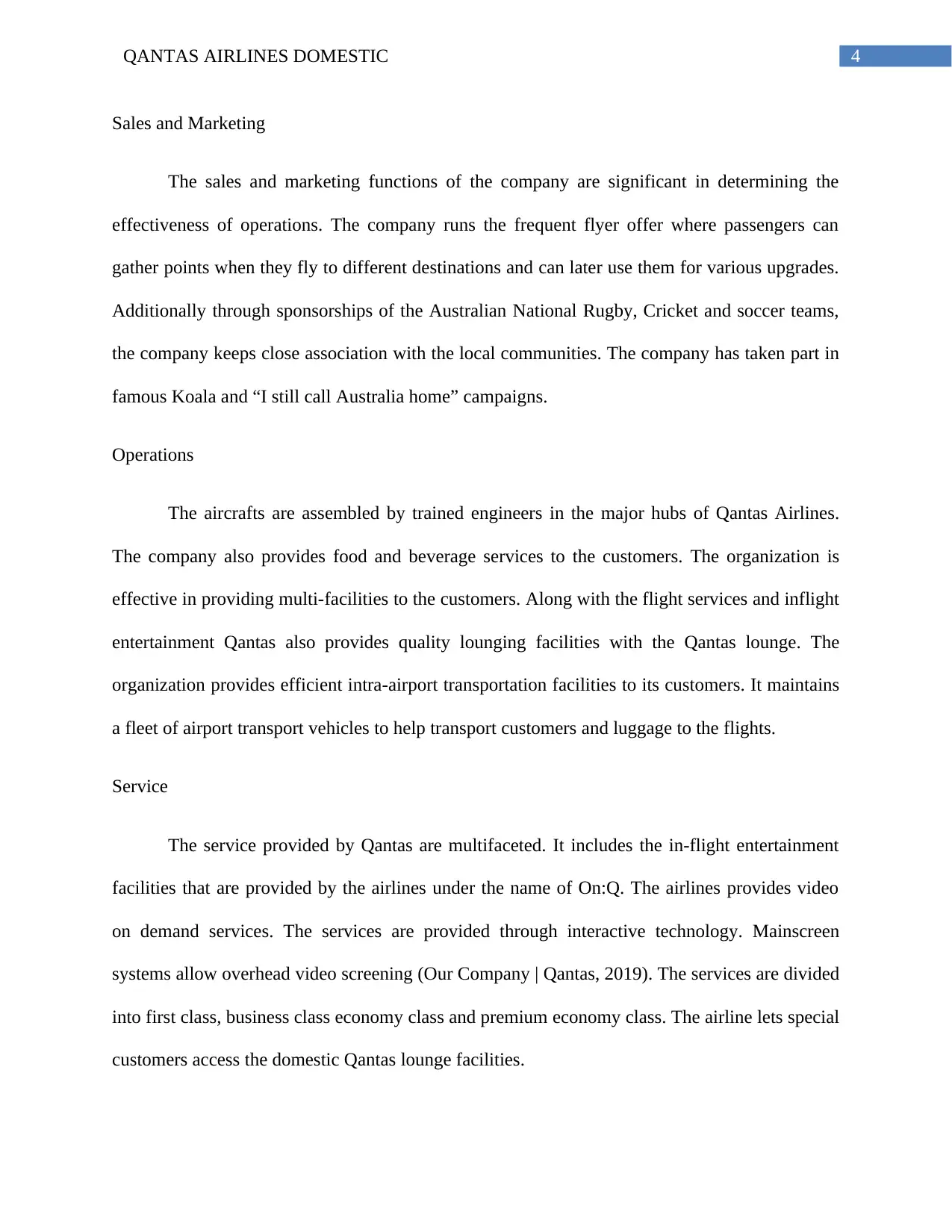
4QANTAS AIRLINES DOMESTIC
Sales and Marketing
The sales and marketing functions of the company are significant in determining the
effectiveness of operations. The company runs the frequent flyer offer where passengers can
gather points when they fly to different destinations and can later use them for various upgrades.
Additionally through sponsorships of the Australian National Rugby, Cricket and soccer teams,
the company keeps close association with the local communities. The company has taken part in
famous Koala and “I still call Australia home” campaigns.
Operations
The aircrafts are assembled by trained engineers in the major hubs of Qantas Airlines.
The company also provides food and beverage services to the customers. The organization is
effective in providing multi-facilities to the customers. Along with the flight services and inflight
entertainment Qantas also provides quality lounging facilities with the Qantas lounge. The
organization provides efficient intra-airport transportation facilities to its customers. It maintains
a fleet of airport transport vehicles to help transport customers and luggage to the flights.
Service
The service provided by Qantas are multifaceted. It includes the in-flight entertainment
facilities that are provided by the airlines under the name of On:Q. The airlines provides video
on demand services. The services are provided through interactive technology. Mainscreen
systems allow overhead video screening (Our Company | Qantas, 2019). The services are divided
into first class, business class economy class and premium economy class. The airline lets special
customers access the domestic Qantas lounge facilities.
Sales and Marketing
The sales and marketing functions of the company are significant in determining the
effectiveness of operations. The company runs the frequent flyer offer where passengers can
gather points when they fly to different destinations and can later use them for various upgrades.
Additionally through sponsorships of the Australian National Rugby, Cricket and soccer teams,
the company keeps close association with the local communities. The company has taken part in
famous Koala and “I still call Australia home” campaigns.
Operations
The aircrafts are assembled by trained engineers in the major hubs of Qantas Airlines.
The company also provides food and beverage services to the customers. The organization is
effective in providing multi-facilities to the customers. Along with the flight services and inflight
entertainment Qantas also provides quality lounging facilities with the Qantas lounge. The
organization provides efficient intra-airport transportation facilities to its customers. It maintains
a fleet of airport transport vehicles to help transport customers and luggage to the flights.
Service
The service provided by Qantas are multifaceted. It includes the in-flight entertainment
facilities that are provided by the airlines under the name of On:Q. The airlines provides video
on demand services. The services are provided through interactive technology. Mainscreen
systems allow overhead video screening (Our Company | Qantas, 2019). The services are divided
into first class, business class economy class and premium economy class. The airline lets special
customers access the domestic Qantas lounge facilities.
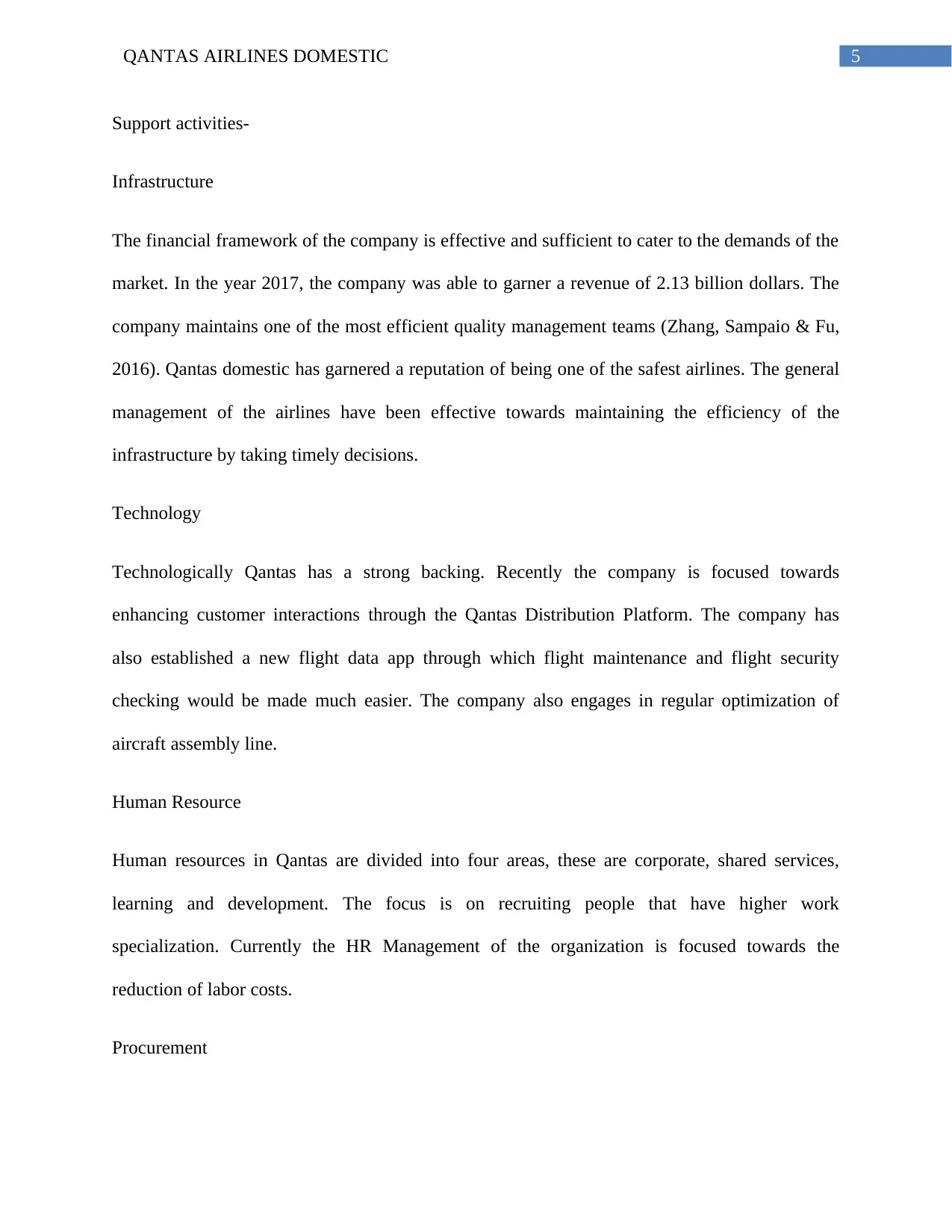
5QANTAS AIRLINES DOMESTIC
Support activities-
Infrastructure
The financial framework of the company is effective and sufficient to cater to the demands of the
market. In the year 2017, the company was able to garner a revenue of 2.13 billion dollars. The
company maintains one of the most efficient quality management teams (Zhang, Sampaio & Fu,
2016). Qantas domestic has garnered a reputation of being one of the safest airlines. The general
management of the airlines have been effective towards maintaining the efficiency of the
infrastructure by taking timely decisions.
Technology
Technologically Qantas has a strong backing. Recently the company is focused towards
enhancing customer interactions through the Qantas Distribution Platform. The company has
also established a new flight data app through which flight maintenance and flight security
checking would be made much easier. The company also engages in regular optimization of
aircraft assembly line.
Human Resource
Human resources in Qantas are divided into four areas, these are corporate, shared services,
learning and development. The focus is on recruiting people that have higher work
specialization. Currently the HR Management of the organization is focused towards the
reduction of labor costs.
Procurement
Support activities-
Infrastructure
The financial framework of the company is effective and sufficient to cater to the demands of the
market. In the year 2017, the company was able to garner a revenue of 2.13 billion dollars. The
company maintains one of the most efficient quality management teams (Zhang, Sampaio & Fu,
2016). Qantas domestic has garnered a reputation of being one of the safest airlines. The general
management of the airlines have been effective towards maintaining the efficiency of the
infrastructure by taking timely decisions.
Technology
Technologically Qantas has a strong backing. Recently the company is focused towards
enhancing customer interactions through the Qantas Distribution Platform. The company has
also established a new flight data app through which flight maintenance and flight security
checking would be made much easier. The company also engages in regular optimization of
aircraft assembly line.
Human Resource
Human resources in Qantas are divided into four areas, these are corporate, shared services,
learning and development. The focus is on recruiting people that have higher work
specialization. Currently the HR Management of the organization is focused towards the
reduction of labor costs.
Procurement
⊘ This is a preview!⊘
Do you want full access?
Subscribe today to unlock all pages.

Trusted by 1+ million students worldwide
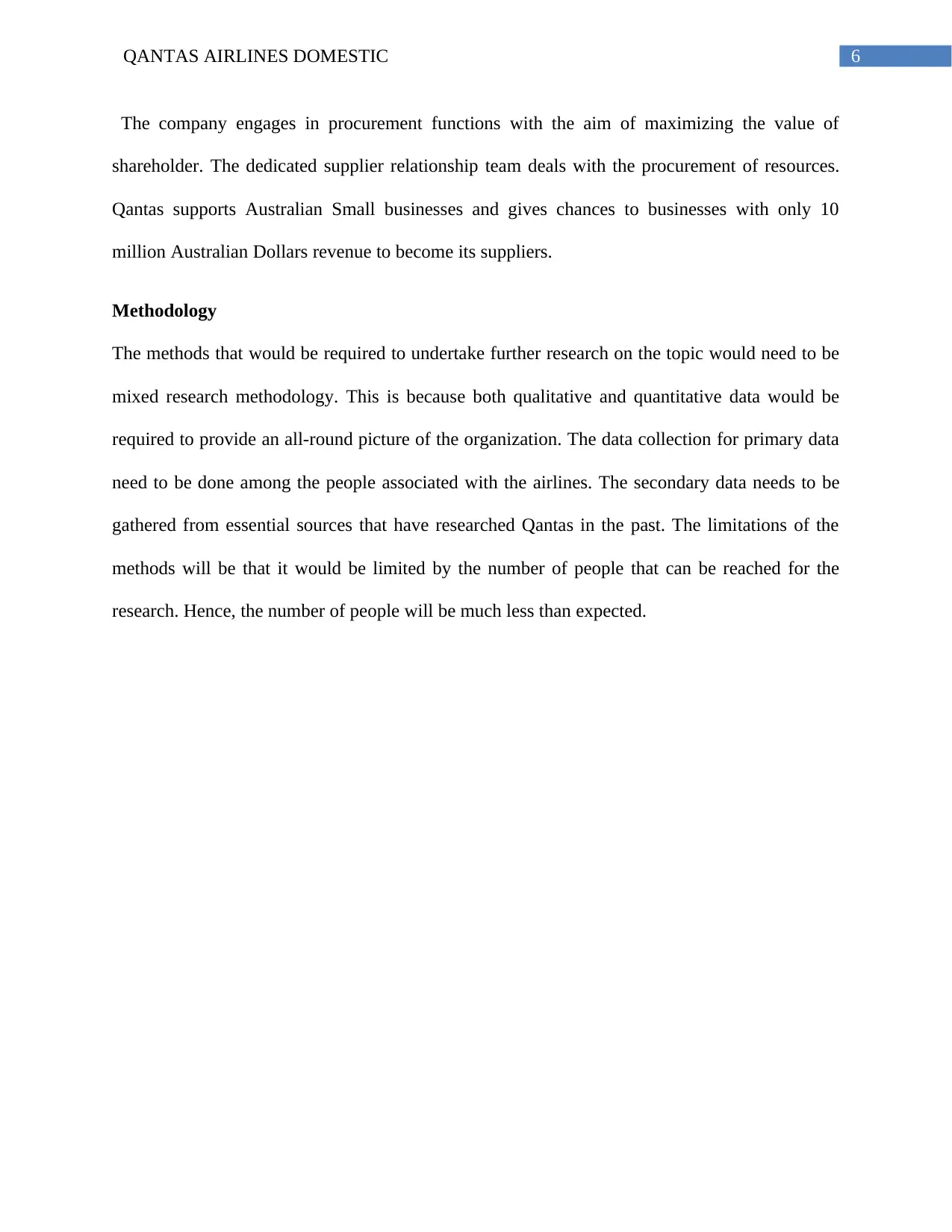
6QANTAS AIRLINES DOMESTIC
The company engages in procurement functions with the aim of maximizing the value of
shareholder. The dedicated supplier relationship team deals with the procurement of resources.
Qantas supports Australian Small businesses and gives chances to businesses with only 10
million Australian Dollars revenue to become its suppliers.
Methodology
The methods that would be required to undertake further research on the topic would need to be
mixed research methodology. This is because both qualitative and quantitative data would be
required to provide an all-round picture of the organization. The data collection for primary data
need to be done among the people associated with the airlines. The secondary data needs to be
gathered from essential sources that have researched Qantas in the past. The limitations of the
methods will be that it would be limited by the number of people that can be reached for the
research. Hence, the number of people will be much less than expected.
The company engages in procurement functions with the aim of maximizing the value of
shareholder. The dedicated supplier relationship team deals with the procurement of resources.
Qantas supports Australian Small businesses and gives chances to businesses with only 10
million Australian Dollars revenue to become its suppliers.
Methodology
The methods that would be required to undertake further research on the topic would need to be
mixed research methodology. This is because both qualitative and quantitative data would be
required to provide an all-round picture of the organization. The data collection for primary data
need to be done among the people associated with the airlines. The secondary data needs to be
gathered from essential sources that have researched Qantas in the past. The limitations of the
methods will be that it would be limited by the number of people that can be reached for the
research. Hence, the number of people will be much less than expected.
Paraphrase This Document
Need a fresh take? Get an instant paraphrase of this document with our AI Paraphraser
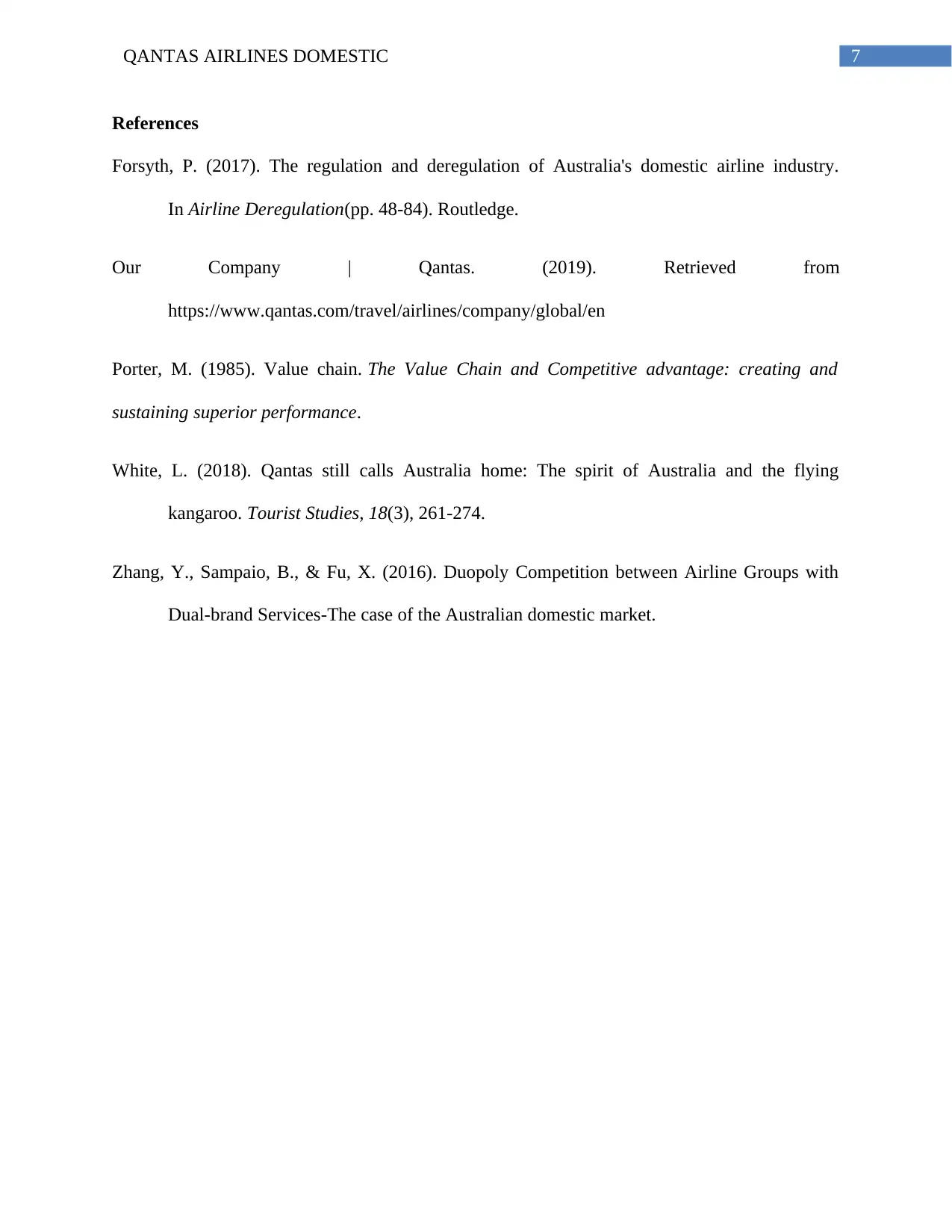
7QANTAS AIRLINES DOMESTIC
References
Forsyth, P. (2017). The regulation and deregulation of Australia's domestic airline industry.
In Airline Deregulation(pp. 48-84). Routledge.
Our Company | Qantas. (2019). Retrieved from
https://www.qantas.com/travel/airlines/company/global/en
Porter, M. (1985). Value chain. The Value Chain and Competitive advantage: creating and
sustaining superior performance.
White, L. (2018). Qantas still calls Australia home: The spirit of Australia and the flying
kangaroo. Tourist Studies, 18(3), 261-274.
Zhang, Y., Sampaio, B., & Fu, X. (2016). Duopoly Competition between Airline Groups with
Dual-brand Services-The case of the Australian domestic market.
References
Forsyth, P. (2017). The regulation and deregulation of Australia's domestic airline industry.
In Airline Deregulation(pp. 48-84). Routledge.
Our Company | Qantas. (2019). Retrieved from
https://www.qantas.com/travel/airlines/company/global/en
Porter, M. (1985). Value chain. The Value Chain and Competitive advantage: creating and
sustaining superior performance.
White, L. (2018). Qantas still calls Australia home: The spirit of Australia and the flying
kangaroo. Tourist Studies, 18(3), 261-274.
Zhang, Y., Sampaio, B., & Fu, X. (2016). Duopoly Competition between Airline Groups with
Dual-brand Services-The case of the Australian domestic market.
1 out of 8
Related Documents
Your All-in-One AI-Powered Toolkit for Academic Success.
+13062052269
info@desklib.com
Available 24*7 on WhatsApp / Email
![[object Object]](/_next/static/media/star-bottom.7253800d.svg)
Unlock your academic potential
Copyright © 2020–2025 A2Z Services. All Rights Reserved. Developed and managed by ZUCOL.





